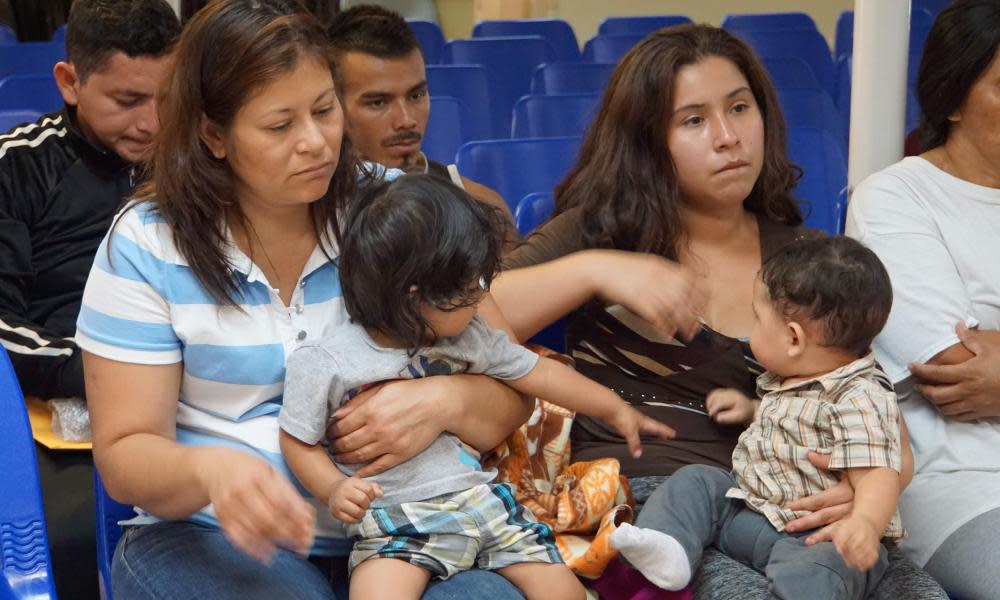Lawyers 'not confident' family separations will end despite Trump order

Donald Trump on Thursday put an end to his family separation policy, but attorneys are concerned the practice will continue, as they struggle to reunite parents and children without any mechanism in place to do so.
“If you look at the language of the executive order it provides wiggle room for the administration,” said Jeremy McKinney, an immigration attorney in South Carolina.
McKinney said he was “not confident at all” that family separations were coming to an end because the language of the executive order includes provisions that families can stay together, depending on government resources, and that they can be separated if the government decides families are in danger.
“We’ve seen this administration make numerous allegations of smuggling at people,” McKinney said. “We’ve all heard the president mention this himself, about people using children as a passport to the US. These types of allegations could be used to break up families.”
Separately, he was concerned that the executive order did not include a plan to reunite families. “All of us are currently living in the chaos of the current situation when you’ve got approximately 2,300 children who were separated from their parents” said McKinney, the national treasurer of the American Immigration Lawyers Association.
He noted that the government’s plan so far for reuniting families has been providing detained parents with a one-page document instructing adults to contact a phone number or email for help in finding their child.
McKinney said detention facilities have different rules about phone access. “Imagine if you’re in a tent city, imagine if you are in some temporary ad hoc central that was created within days, what kind of access you are going to have there?” he said.
The first lady Melania Trump said she supported families reuniting during a tour of a border shelter facility on Thursday morning, but chaos remains at the border, where advocates and attorneys wait to see how the latest development plays out.
Mass family separations first began in April, when the administration announced a “zero tolerance” policy that saw parents placed in adult detention facilities and children labeled “unaccompanied alien minors” and placed in health department-operated shelters.
But in the months leading up to the policy’s official enactment, immigrants rights groups had warned that family separation was already taking place. A group of six immigration organizations filed a complaint with the Department of Homeland Security (DHS) in December 2017, after documenting at least 175 cases of family separation at the border that year.
When asked how it planned to reunite children and families, the health department’s administration for children and families said in a statement it was “awaiting further guidance on the implementation of the executive order”.
The agency oversees the care and shelter of unaccompanied children, who have usually crossed the border by themselves and are waiting to be reunited with their parents or other relatives in the US.
By separating migrant children from their parents, the government created an influx of unaccompanied children who could shift the balance of these shelters and impact the agency’s ability to reunite children with their parents, because their parent is in detention or has been deported.
“Reunification is always the ultimate goal of those entrusted with the care of unaccompanied alien children, and we are working toward that for those unaccompanied alien children currently in our custody,” HHS said.
The American Civil Liberties Union in February brought a lawsuit in response to one incident of family separation, where a Congolese mother seeking asylum was separated from her seven-year-old daughter for four months.
Lee Gelernt, the attorney on that case, said the circumstances that led to the separation of the child and mother, known as Ms L in court documents, could happen again.
Migrant children can be separated from their parents if authorities prove they are unfit to parent the child, are abusive or neglectful, but Gelernt said: “What we’ve seen is the government decide it is in the best interest to take the child away in other situations.”
Ms L and her daughter were reunited shortly after the ACLU expanded her case into a class-action lawsuit seeking an end to family separation.
Gelernt, deputy director of the ACLU’s Immigrants’ Rights Project, said the group is still pushing for the judge to rule family separations illegal because of the loopholes in the executive order. He said the ACLU also plans to ask the judge to demand the government quickly reunite the children who have already been separated.
“When the government wants to arrest people they get the resources together,” Gelernt said. “And this is a crisis they created and they need to fix it.”

 Yahoo News
Yahoo News 
